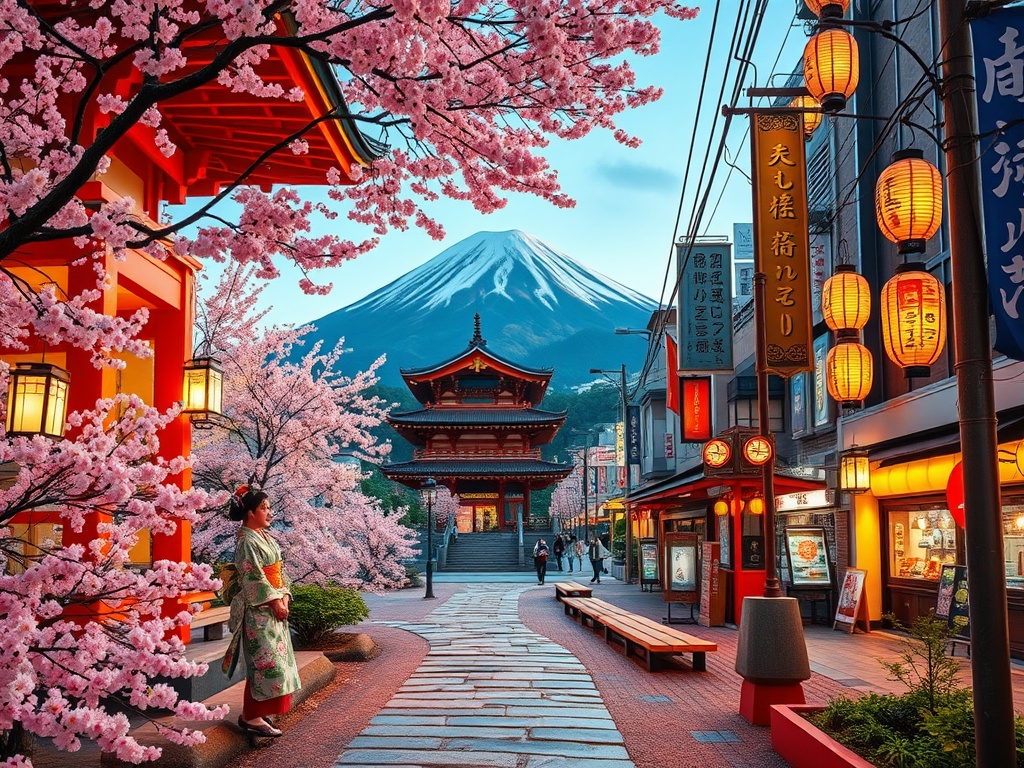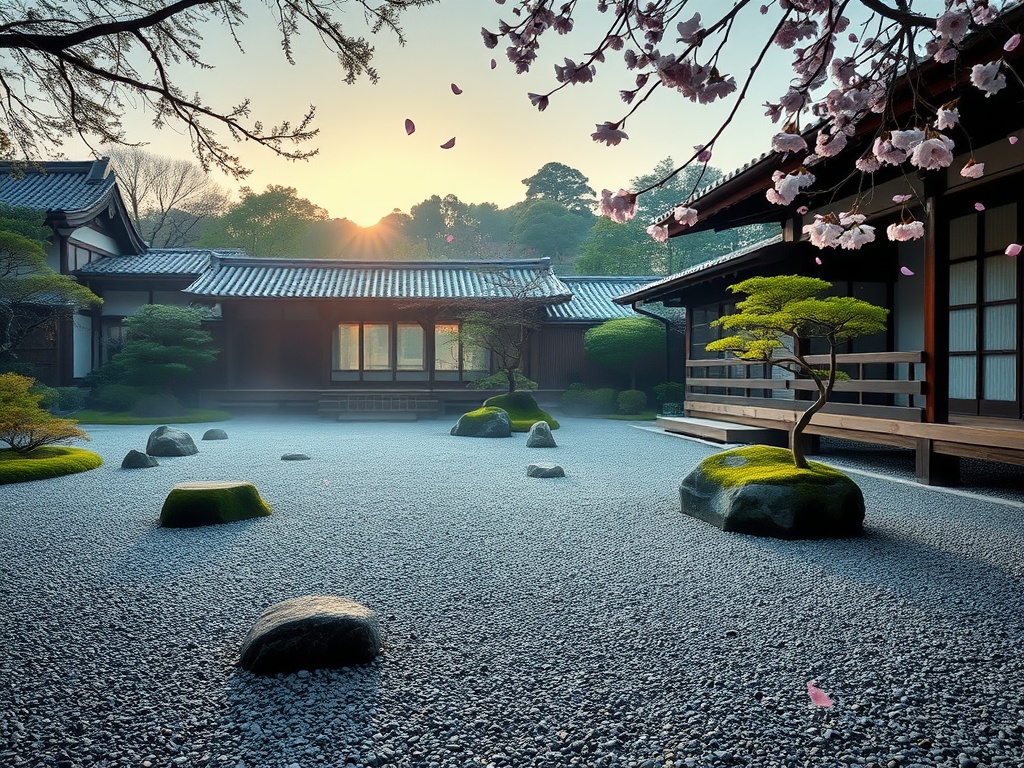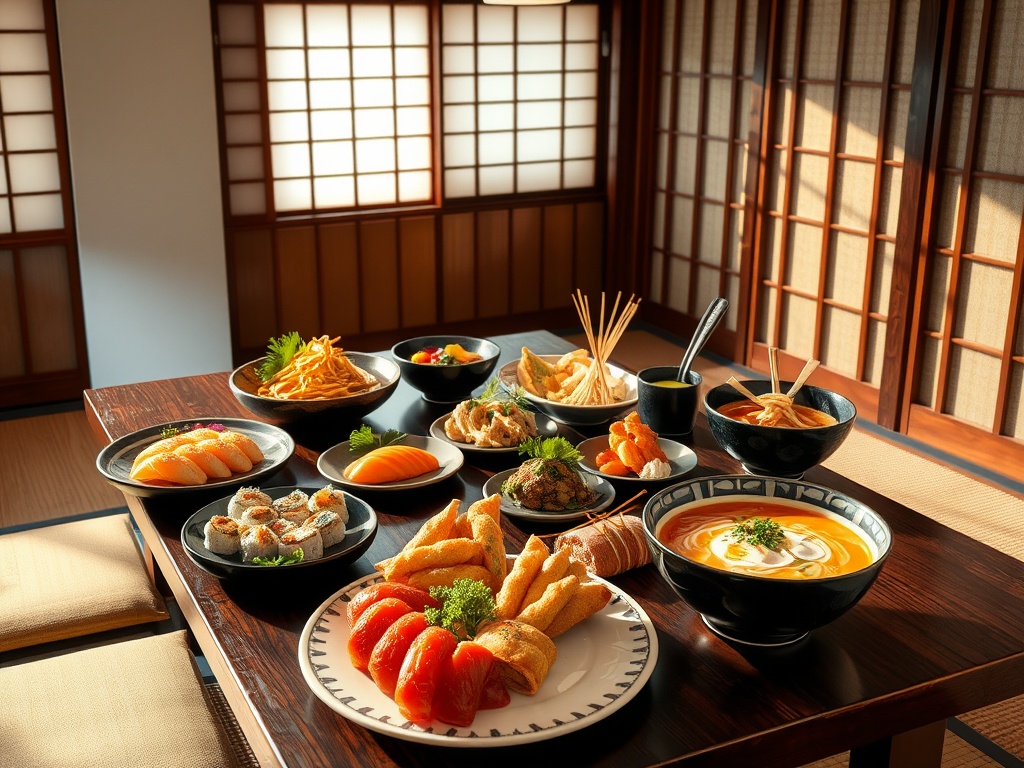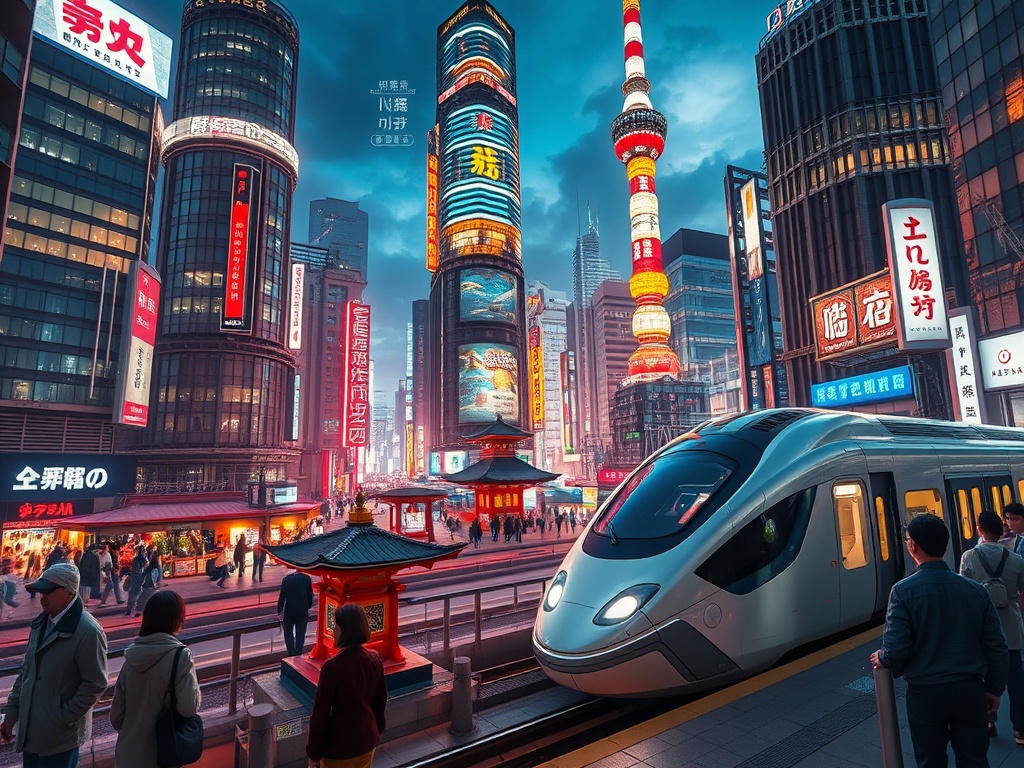The Art of Zen: Unveiling Japan’s Spiritual Harmony
Win a Free Trip to Japan!
Experience cherry blossoms and ancient temples
Japan is a land where ancient traditions gracefully meet modern marvels, and one of the most profound aspects of its culture is Zen. Zen is more than just a spiritual practice; it is a way of life that permeates Japanese culture, art, and architecture. For travel and tourism enthusiasts, exploring the Zen elements in Japan offers a unique glimpse into the country’s pursuit of spiritual harmony and inner peace.
Zen gardens, or karesansui, are quintessential representations of Japanese Zen philosophy. These meticulously designed landscapes use rocks, sand, and minimalistic elements to symbolize nature’s beauty. The gardens invite visitors to pause, reflect, and find tranquility amidst the chaos of life. Kyoto, often considered the Zen capital, houses some of the most breathtaking Zen gardens, such as the famed Ryoan-ji.
Zen is not confined to temples and gardens; it extends to daily practices that emphasize mindfulness and simplicity. From the art of tea ceremonies to the meditative practice of calligraphy, Zen encourages individuals to find beauty in the mundane. These practices not only offer a spiritual retreat but also invite travelers to immerse themselves fully in the present moment.
Experiences to Embark On:
- Participate in a traditional tea ceremony to experience the ‘Way of Tea.’
- Visit a Zen monastery to learn about and practice Zazen meditation.
- Explore the art of Japanese calligraphy to understand the Zen principle of ‘no mind.’
Culinary Odyssey: Savoring the Flavors of Japan
Embarking on a culinary journey through Japan is akin to exploring a treasure trove of flavors that reflect the country’s rich heritage and vibrant culture. Japanese cuisine is a harmonious blend of traditional techniques and innovative creations, offering an unforgettable gastronomic experience for travel and tourism enthusiasts. Whether you’re wandering through bustling street markets or dining at Michelin-starred restaurants, every bite tells a story of Japan’s culinary evolution.
Traditional Japanese cuisine, or washoku, is a UNESCO Intangible Cultural Heritage, celebrated for its emphasis on seasonal ingredients, presentation, and harmony of flavors. Sushi and sashimi are quintessential dishes that showcase the art of simplicity, where the freshness of the ingredients takes center stage. Meanwhile, the savory allure of ramen, with its myriad regional varieties, offers a comforting embrace with every slurp. Traveling through Japan, you’ll encounter local delicacies unique to each region, such as the delicate kaiseki meals of Kyoto and the robust flavors of Osaka’s okonomiyaki.
A kaiseki meal is more than just a dinner; it’s an artistic presentation that engages all the senses. Originating from the traditional tea ceremony, kaiseki embodies the principles of balance, taste, texture, and appearance. Each dish is meticulously crafted to highlight the finest seasonal ingredients, often served in exquisite pottery that complements the meal’s aesthetic. As you savor each course, from the delicate sashimi to the intricately prepared desserts, you are invited to partake in a culinary symphony that mirrors the Zen philosophy of harmony and mindfulness.
Wonders of Innovation: The Futuristic Face of Japan
Japan stands at the forefront of technological advancement, seamlessly fusing tradition with innovation to create a landscape that feels both rooted in history and ahead of its time. For travel and tourism enthusiasts, exploring Japan’s modern marvels offers a tantalizing glimpse into the future, where cutting-edge technology and sustainability go hand in hand. From towering skyscrapers to automated conveniences, Japan’s futuristic allure is a testament to its relentless pursuit of progress.
Tokyo, the bustling capital, is often the first stop for travelers seeking the epitome of urban innovation. The city is a living testament to Japan’s prowess in integrating technology with everyday life. Skyscrapers adorned with dazzling digital displays define the skyline, while the seamless efficiency of the Shinkansen, or bullet train, exemplifies Japan’s commitment to high-speed connectivity. In districts like Akihabara, visitors can immerse themselves in a world of robotics and anime culture, showcasing the fusion of digital art and cutting-edge technology. Meanwhile, the Odaiba waterfront area stands as an icon of futuristic design, featuring attractions like the Miraikan – The National Museum of Emerging Science and Innovation.
Beyond the urban sprawl, Japan is also a leader in sustainable innovation. The country has embraced smart city concepts, aiming to create eco-friendly urban environments that prioritize efficiency and livability. Fujisawa Sustainable Smart Town, just outside Tokyo, is a pioneering community that leverages solar energy, smart grids, and home automation to minimize its carbon footprint. Similarly, the city of Yokohama has implemented initiatives to reduce emissions and promote green transportation. These efforts reflect Japan’s commitment to a sustainable future, making it a must-visit for those interested in sustainable living solutions.
Cherry Blossoms & Beyond: Exploring Japan’s Natural Beauty
Japan’s natural beauty is a remarkable spectacle that captivates the hearts of travelers and nature enthusiasts alike. From the iconic cherry blossoms that paint the landscape in delicate hues of pink to the majestic mountains that stand as sentinels of time, Japan offers a diverse array of natural wonders waiting to be explored. Each season unveils a new canvas of breathtaking scenery, inviting visitors to lose themselves in the serene embrace of nature. Whether you’re wandering through ancient forests, soaking in hot springs, or hiking up volcanic peaks, Japan’s natural beauty promises a journey of discovery and awe.
Cherry blossoms, or sakura, are perhaps the most iconic symbol of Japan’s natural beauty. Every spring, these ethereal flowers blanket the country in a sea of pink and white, drawing visitors from around the globe to partake in the fleeting beauty of hanami, or cherry blossom viewing. Cities like Tokyo, Kyoto, and Hiroshima become vibrant spectacles as locals and tourists gather in parks to celebrate the ephemeral nature of life, a concept deeply rooted in Japanese culture. The cherry blossom season is more than just a visual feast; it’s a time of reflection, renewal, and joy, offering a profound connection to the rhythms of nature.
While the cherry blossoms are a highlight, Japan’s natural beauty extends far beyond the springtime blooms. The country’s diverse landscapes offer a wealth of experiences throughout the year. In the summer, lush green forests and pristine beaches provide a refreshing escape from the urban bustle. As autumn arrives, the foliage transforms into a fiery tapestry of reds, oranges, and yellows, creating a breathtaking backdrop for hiking and exploration. Winter brings its own charm, with snowy landscapes and hot springs offering a tranquil retreat. From the towering peaks of the Japanese Alps to the serene shores of Okinawa, Japan’s natural beauty is as varied as it is stunning.
The Samurai Legacy: A Journey Through Japan’s Historical Tapestry
In the annals of Japanese history, the Samurai stand as legendary figures whose influence continues to permeate modern culture. These warriors, bound by the code of Bushido, not only shaped the sociopolitical landscape of Japan for centuries but also enriched its cultural heritage. For travel and tourism enthusiasts, delving into the Samurai legacy offers a captivating window into the past, where honor, discipline, and martial prowess were the pillars of society. As you traverse Japan, you’ll find that the echoes of the Samurai era resonate through its castles, museums, and festivals, inviting you to embark on a historical odyssey.
The essence of the Samurai is encapsulated in the Bushido code, a moral and ethical framework that governed their way of life. This code emphasized virtues such as loyalty, courage, and benevolence, setting a standard for conduct that extended beyond the battlefield. In cities like Kamakura and Kyoto, the influence of Bushido is palpable, with historic sites and monuments paying homage to the Samurai ethos. Visitors can explore temples and shrines where warriors once sought spiritual guidance and reflect on the principles that sculpted one of history’s most esteemed warrior classes.
The architectural grandeur of Japan’s castles offers a glimpse into the strategic genius of the Samurai era. These fortresses served not only as military bastions but also as centers of governance and culture. The imposing presence of Himeji Castle, often referred to as the ‘White Heron,’ stands as a testament to the era’s architectural ingenuity. Meanwhile, the battlefields of Sekigahara and Nagashino transport visitors back to pivotal moments in Japanese history, where Samurai clans clashed for supremacy. Exploring these sites allows travel enthusiasts to step into the shoes of the warriors who shaped Japan’s destiny.
Pop Culture Phenomenon: Dive into Japan’s Vibrant Entertainment World
The vibrant tapestry of Japanese pop culture has captivated global audiences, seamlessly weaving traditional elements with modern influences. From the neon-lit streets of Tokyo’s Akihabara district to the global phenomenon of anime and manga, Japan’s entertainment world offers an exhilarating experience for travel and tourism enthusiasts. This dynamic realm invites you to explore a landscape where creativity knows no bounds, and where every corner reveals something delightfully unexpected.
Anime and Manga: The Heartbeat of Japanese Pop Culture Japanese anime and manga have transcended borders, becoming beloved staples for fans worldwide. This art form, characterized by its unique storytelling and expressive characters, offers a window into the imaginative minds of Japanese creators. In districts like Akihabara and Ikebukuro, you’ll find themed cafes, merchandise, and events dedicated to these animated wonders. Whether you’re a casual viewer or a die-hard fan, immersing yourself in Japan’s anime and manga culture is a must. Discover the excitement of attending anime conventions or visiting the iconic Studio Ghibli Museum, where the magic of these stories comes to life.
J-Pop and Idols: The Soundtrack of Modern Japan J-Pop, or Japanese pop music, provides the infectious rhythm that pulses through the nation’s cultural veins. This genre, known for its catchy melodies and vibrant performances, has spawned an entire industry of idol groups that enjoy immense popularity. Experience the energy of a live J-Pop concert or attend a handshake event to see the devotion of fans firsthand. Idol culture, with its elaborate costumes and synchronized dances, offers a fascinating glimpse into a uniquely Japanese form of entertainment. While exploring cities like Osaka and Fukuoka, you’ll discover venues where these performers shine, enriching your journey with the sounds of contemporary Japan.
Gaming Galore: Japan’s Digital Playground Japan is a mecca for gaming enthusiasts, home to industry giants like Nintendo and Sony. The country’s passion for gaming extends beyond consoles, with arcades offering endless hours of fun. Step into the world of retro gaming in Shibuya or experience cutting-edge virtual reality in Shinjuku. The gaming culture here is a testament to Japan’s innovative spirit, where tradition meets technology in unexpected ways. Whether you’re reliving the classics or exploring the latest releases, Japan’s gaming scene promises an adventure that’s as thrilling as it is nostalgic.
The Architectural Symphony: Traditional Meets Modern in Japan
Japan’s architectural landscape is a mesmerizing blend of timeless tradition and cutting-edge modernity, where ancient temples stand in harmony with futuristic skyscrapers. This architectural symphony is a testament to Japan’s ability to honor its past while embracing the future, offering travel and tourism enthusiasts a captivating exploration of design and innovation. From serene shrines nestled in tranquil gardens to avant-garde structures that push the boundaries of imagination, Japan’s architectural wonders are a reflection of its rich cultural tapestry.
Scattered across the Japanese archipelago are sacred temples and shrines, each echoing the whispers of history. These structures, often nestled amidst lush landscapes, invite visitors to step into a world of spiritual serenity. Kyoto, with its treasure trove of temples like Kinkaku-ji, the Golden Pavilion, exemplifies the elegance of Zen architecture with its pristine gardens and reflective ponds. Meanwhile, the Shinto shrines, such as the iconic Fushimi Inari-taisha with its thousands of red torii gates, stand as vibrant testimonies to Japan’s spiritual heritage.
In contrast to the historic elegance of traditional architecture, Japan’s urban landscapes showcase a daring leap into the future. Cities like Tokyo and Osaka are adorned with architectural marvels that defy conventional design. The Tokyo Skytree, a beacon of modern engineering, offers panoramic views of the sprawling metropolis below. Equally impressive is the Asahi Beer Hall, designed by Philippe Starck, with its iconic golden ‘Flame.’ These structures, with their innovative designs and sustainable technologies, illustrate Japan’s commitment to progress and its role as a leader in modern architecture.
- Nijo Castle, Kyoto: A UNESCO World Heritage Site, this castle is renowned for its exquisite gardens and ‘nightingale’ floors that chirp when stepped upon, designed to thwart intruders.
- Osaka Castle, Osaka: A symbol of power, this castle features panoramic views and fascinating historical exhibits.
- TeamLab Borderless, Tokyo: An immersive digital art museum that blurs the line between structure and art.
Festivals of Fire and Lights: Celebrating Japan’s Unique Traditions
Japan’s cultural tapestry is a vibrant amalgamation of age-old traditions and contemporary influences, where festivals play a pivotal role in illuminating the country’s rich heritage. Among these, the festivals of fire and lights stand out as some of the most spectacular celebrations, drawing tourists from around the globe with their breathtaking displays and deep-rooted cultural significance. These events are not merely about visual grandeur; they are a profound expression of Japan’s connection with nature, spirituality, and community.
Fire festivals, or hi-matsuri, are a captivating spectacle where flames become a medium of purification and celebration. One of the most illustrious is the Nachi Fire Festival in Wakayama, where giant torches parade through the sacred Nachi Falls, creating a mesmerizing dance of light and shadow. Similarly, the Kurama Fire Festival in Kyoto is a fiery homage to the spirits, featuring torches and bonfires that transform the mountain village into a glowing sea of light. These festivals are a testament to Japan’s ancient rituals and its people’s reverence for fire as a life-giving force.
As the seasons change, Japan’s landscapes are often adorned with enchanting light displays that captivate both locals and visitors. The winter months usher in a wave of illuminations, where cities and towns are transformed into radiant wonderlands. The Sapporo Snow Festival is famed for its intricate ice sculptures illuminated against the night sky, while the Nabana no Sato in Mie Prefecture boasts one of the largest light displays in the country, with millions of LED lights creating magical scenes. These illuminations not only celebrate the beauty of the seasons but also highlight Japan’s mastery in balancing tradition with modernity.
Whether you find yourself entranced by the flicker of flames or the glow of lights, Japan’s festivities offer a unique lens through which to experience its cultural depth and artistic brilliance. Each festival is an invitation to immerse oneself in the narratives that have shaped the nation’s identity, providing travel enthusiasts with unforgettable moments of awe and inspiration.



